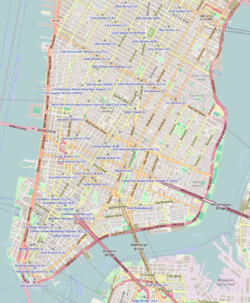United States Post Office Cooper Station | |
 (2023) | |
| Location | 93 4th Avenue Manhattan, New York City |
|---|---|
| Coordinates | 40°43′55″N73°59′24″W / 40.73194°N 73.99000°W |
| Built | 1937 [1] |
| Architect | William Dewey Foster |
| Architectural style | Art Moderne [1] |
| MPS | US Post Offices in New York State, 1858-1943, TR |
| NRHP reference No. | 88002360 |
| NYSRHP No. | 06101.001781 |
| Significant dates | |
| Added to NRHP | May 11, 1989 [2] |
| Designated NYSRHP | May 11, 1989 |
The United States Post Office Cooper Station, located at 93 Fourth Avenue, on the corner of East 11th Street in Manhattan, New York City, was built in 1937, and was designed by consulting architect William Dewey Foster in the Art Moderne style for the Office of the Supervising Architect of the United States Department of the Treasury. It serves the 10003 ZIP code, which covers the neighborhood of the East Village. Its sub-station is located on East 3rd Street near Avenue C. [3]
Contents

The post office is named in honor of Peter Cooper, the mid-19th century industrialist and philanthropist who founded the nearby The Cooper Union for the Advancement of Science and Art.
The building was listed on the National Register of Historic Places in 1989. [2]



